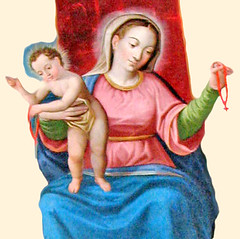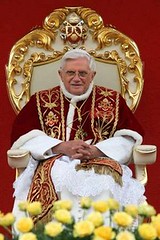Four Reasons for Candlemas
 Tomorrow, forty days after Christmas, the Liturgy commemorates the Presentation of the Lord in the Temple and the Purification of the Blessed Virgin Mary, in fulfilment of the Jewish Law. This feast brings to a close the extended season of Christmas and we, here in Blackfriars Cambridge, will finally take down our Christmas trees and put away the Crib! One of the names associated with this Feast is Candlemas and the characteristic rite of the Liturgy is the blessing of and procession with candles. The most obvious reason for this feast of light is to celebrate the True Light, Jesus Christ, whom Simeon foretold would be a "light to enlighten the Gentiles". However, the 'Golden Legend' of Fra' Jacobus de Voragine - as always - gives us other illuminating reasons for blessing and processing with candles on the Feast of Candlemas:
Tomorrow, forty days after Christmas, the Liturgy commemorates the Presentation of the Lord in the Temple and the Purification of the Blessed Virgin Mary, in fulfilment of the Jewish Law. This feast brings to a close the extended season of Christmas and we, here in Blackfriars Cambridge, will finally take down our Christmas trees and put away the Crib! One of the names associated with this Feast is Candlemas and the characteristic rite of the Liturgy is the blessing of and procession with candles. The most obvious reason for this feast of light is to celebrate the True Light, Jesus Christ, whom Simeon foretold would be a "light to enlighten the Gentiles". However, the 'Golden Legend' of Fra' Jacobus de Voragine - as always - gives us other illuminating reasons for blessing and processing with candles on the Feast of Candlemas:"The Church established this usage for four reasons. The first is to do away with an erroneous custom. On the calends of February the Romans honoured Februa, mother of Mars the god of war, by lighting the city with candles and torches throughout the night of that day. This they did every fifth year (that span of years being called a 'lustrum') in order to obtain victory over their enemies from the son whose mother they so solemnly celebrated. Also in February the Romans sacrificed to Februus, i.e., to Pluto and the other gods of the underworld, that the gods might be propitious to the souls of their ancestors: they made solemn offerings to them and sang their praises throughout the night by the light of candles and torches. Pope Innocent says that the Roman wives observed a feast of lights that had its origins in some poets' fables, according to which Prosepina was so beautiful that the god Pluto, smitten with desire, abducted her and made her a goddess. Her kinsmen sought her for a long time through the forests and woodlands with torches and lanterns, and the Roman wives imitated this, going about with torches and candles. Since it is hard to relinquish such customs and the Christians, converted from paganism, had difficulty giving them up, Pope Sergius transmuted them, decreeing that the faithful should honour the holy mother of the Lord on this day by lighting up the whole world with lamps and candles. Thus the Roman celebration survived but with an altered meaning.
Another reason for solemnizing the feast of Candlemas was to show the purity of the Virgin Mary. Some people, hearing that she had accepted purification might think that she had needed to be purified. Therefore to show that she was totally pure and radiant, the Church ordered that we should carry luminous candles, as if the Church were in effect saying: 'O Blessed Virgin, you need no purification! You are wholly shining, wholly resplendent!'...
The third reason for celebrating the feast of Candlemas is to recall the procession that occurred on this day, when Mary and Joseph and Simeon and Anna formed a solemn procession and presented the child Jesus in the Temple. On the feast day we too make a procession, carrying in our hands a lighted candle which signifies Jesus, and bearinng it into the churches. In the candle there are three things - the wick, the wax and the fire. These three signify three things about Christ: the wax is the sign of his body, which was born of the Virgin Mary without corruption of the flesh, as bees make honey without mingling with each other; the wick signifies his most pure soul, hidden in his body; the fire or the light stands for divinity, because God is a consuming fire...
The fourth reason for celebrating the feast is to instruct us. We learn that if we wish to be purified and clean before God, we have three things in us, namely, true faith, good works and right intention. The lighted candle in the hand is faith with good works; for as a candle without a light is said to be dead, and as a light does not illumine without a candle and seems to be dead, so works without faith and faith without good works can be called dead. The wick hidden within the wax is the right intention, and Gregory says: 'Let the work be visible to the public in such a way that the intention remains in hiding.'"
Incidentally, the Dominican writer goes on to recount a story of a mystical vision of a Mass of Candlemas and says: "When it was time for the offertory, the Queen of the virgins and the other virgins, together with all those in the choir, genuflected and offered their candles to the priest, as is customary." Of course, those who are familiar with the (old Tridentine and/or reformed, Vatican II) Roman Rite might be rather puzzled by this; the 1962 rubric clearly states that the faithful light their candles during the Sanctus until Communion, so they could not have offered them to the priest at the offertory. What we have here then is a reminder of the antiquity of the Dominican Rite which retained this older form from the early medieval Roman Rite; for we still have the Dominican custom of offering the blessed candles to the Prior at the offertory, which we shall do tomorrow.
And as the candles are offered, this antiphon is sung:
"Felix namque es, sacra virgo Maria, et omne laude dignissima: quia ex te ortus est sol justitiae, Christus Deus noster"
'Happy are you, holy virgin Mary, and most worthy of all praise: because from you arose the sun of justice, Christ our God.'
May we, through her glorious intercession, be inflamed with God's holy charity and so deserve to be presented in the holy temple of God's glory. Amen. (cf Prayer of blessing over the candles)








3 Comments:
A goodly page on Candlemas:
Candlemas
What is the title of that icon of the Blessed Virgin? It's beautiful!
The icon is called 'Mother of God,
Light in All Darkness' and was written by Fr William Hart McNichols.
Post a Comment
<< Home